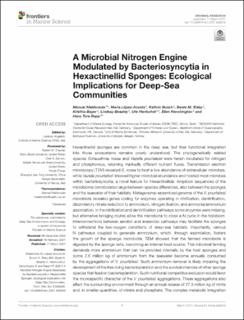| dc.description.abstract | Hexactinellid sponges are common in the deep sea, but their functional integration into those ecosystems remains poorly understood. The phylogenetically related species Schaudinnia rosea and Vazella pourtalesii were herein incubated for nitrogen and phosphorous, returning markedly different nutrient fluxes. Transmission electron microscopy (TEM) revealed S. rosea to host a low abundance of extracellular microbes, while Vazella pourtalesii showed higher microbial abundance and hosted most microbes within bacteriosyncytia, a novel feature for Hexactinellida. Amplicon sequences of the microbiome corroborated large between-species differences, also between the sponges and the seawater of their habitats. Metagenome-assembled genome of the V. pourtalesii microbiota revealed genes coding for enzymes operating in nitrification, denitrification, dissimilatory nitrate reduction to ammonium, nitrogen fixation, and ammonia/ammonium assimilation. In the nitrification and denitrification pathways some enzymes were missing, but alternative bridging routes allow the microbiota to close a N cycle in the holobiont. Interconnections between aerobic and anaerobic pathways may facilitate the sponges to withstand the low-oxygen conditions of deep-sea habitats. Importantly, various N pathways coupled to generate ammonium, which, through assimilation, fosters the growth of the sponge microbiota. TEM showed that the farmed microbiota is digested by the sponge cells, becoming an internal food source. This microbial farming demands more ammonium that can be provided internally by the host sponges and some 2.6 million kg of ammonium from the seawater become annually consumed by the aggregations of V. pourtalesii. Such ammonium removal is likely impairing the development of the free-living bacterioplankton and the survival chances of other sponge species that feed on bacterioplankton. Such nutritional competitive exclusion would favor the monospecific character of the V. pourtalesii aggregations. These aggregations also affect the surrounding environment through an annual release of 27.3 million kg of nitrite and, in smaller quantities, of nitrate and phosphate. The complex metabolic integration among the microbiota and the sponge suggests that the holobiont depends critically on the correct functioning of its N-driven microbial engine. The metabolic intertwining is so delicate that it changed after moving the sponges out of their habitat for a few days, a serious warning on the conservation needs of these sponge aggregations. | en_US |

